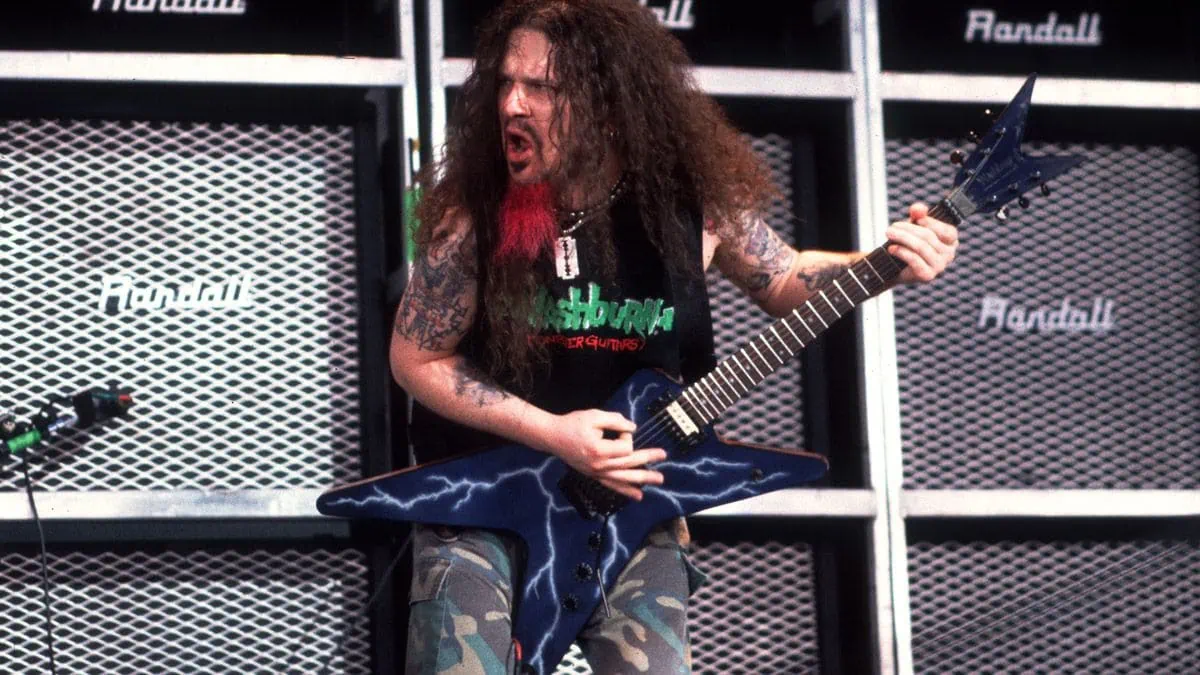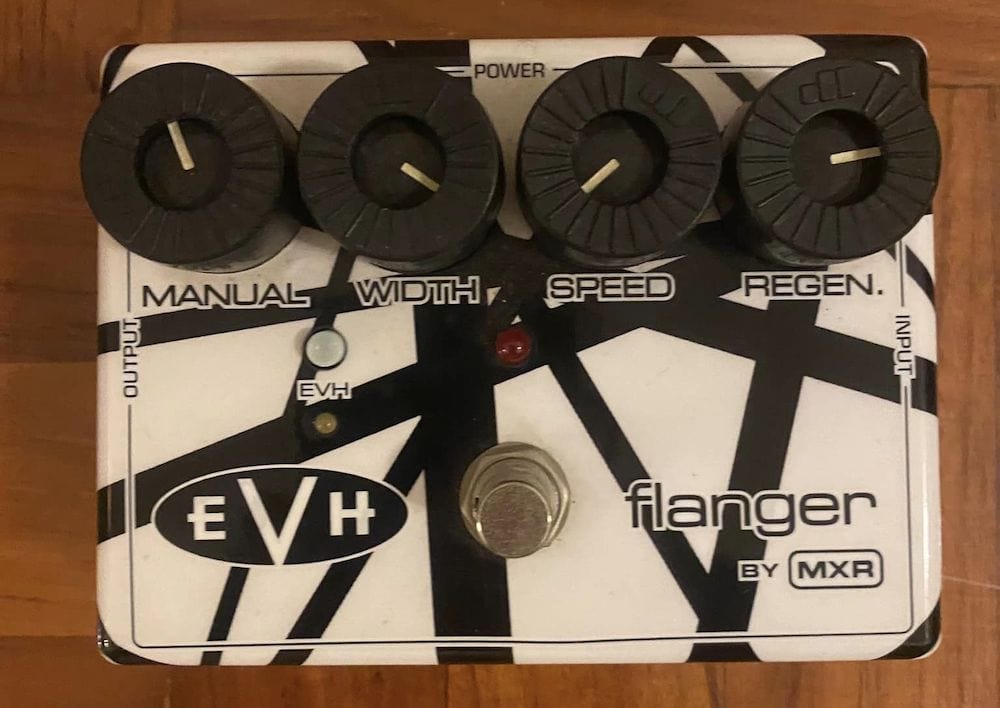“Dimebag” Darrell Lance Abbott was an astonishingly proficient guitar player. Abbott, known affectionately to friends and fans as “Dime”, exploded onto the global metal scene with groove-thrash titans Pantera, unleashing a combination of terrifying technique and undeniable riffs on the unsuspecting glam-addled rock scene.
Darrell’s work with Pantera and, later, Damageplan, cemented his place in the pantheon of metal guitar players. Tragically, Darrell’s life was cut short when he was murdered on stage in 2004.
Darrell’s towering musical legacy will not be forgotten, however. Almost twenty years after he was laid to rest, Pantera’s legions of rabid fans still clamor to capture the ferocity and raw power of his guitar tone.
In this article, I’ll go through the key pieces of gear you need to evoke some of the Pantera magic. In particular, I’ll be basing my recommendations on my favorite Pantera riff, “Walk.”
Table of Contents
Dimebag Darrell Guitars
One of the most enduring images of Dimebag Darrell is on stage, hair and beard flying, while he shreds on a Dean ML. These aggressively-shaped guitars, built like a combination of the Gibson Flying V and Explorer, have an unusual V-shaped headstock and tailpiece, and a slight v-shaped neck to facilitate faster playing.
Dimebag’s signature Dean – nicknamed the “Dean From Hell” – featured a custom blue-and-black lightning bolt paintjob, a Floyd Rose tremolo system, and an ultra-hot Bill Lawrence L-500XL bridge pickup.

This guitar was the mainstay for most of Pantera’s early career, including their oft-forgotten early glam years. Most importantly, however, it was Dime’s main axe for recording Cowboys From Hell and Vulgar Display of Power.
For the Dime tone, I’d recommend this signature guitar as your first port of call. Dean has released many Dime-spec ML guitars over the years, including the Dean From Hell, complete with custom paintjob.
There’s also the Dime-O-Flage Dean. These come with Seymour Duncan Dimebuckers, high-output signature model humbucking pickups. Dimebag Darrell actually designed the Dimebucker with Seymour Duncan to emulate the sound of those original Bill Lawrence humbuckers.
If the Dean isn’t to your taste, I can highly recommend the Epiphone Explorer, as long as you swap out the stock pickups for the Dimebucker. You could also try the ESP LTD Viper, as like the Dean and Epiphone, it has a fast neck and mahogany body.
These features, when coupled with the right high-output humbuckers, should get you in the ballpark of the Dimebag tone.
Dimebag’s Amps

Dime was a devoted player of Randall solid-state amplifiers. Unlike many metal players, Dime preferred the thinner, fizzier sound of solid-state amplification.
Pantera avoided spongy, warm tube saturation in favor of a more aggressive, almost-unpleasant tone. It’s a testament to Dime’s playing ability that he made solid-state amps sound as good as he did in the 90s, when the technology was almost unusable for metal playing.
Dime described his Randall tone as “a little nasty sounding, a little gritty.”
Dime almost exclusively recorded with the Randall RG100H. Be warned: this is an extremely high-powered head with plenty of volume and gain on tap.
If 100 watts of Randall power is too much to consider, I’d recommend the diminutive 1-watt Diavlo head, which is about half the price and a far lower output.
One of the benefits of a solid-state amp is that you can get closer to the tone of a high-watt amplifier at lower wattage. The amplifier does not depend on tube overload to get distorted tones, so you can get a similar sound at lower volume.
I wouldn’t divert too much from Randall amplification for this sound, as, for me, that’s the classic Dime tone.
You could probably get close with a Marshall-style amp from Blackstar, EVH, or Marshall, but the specific type of distortion enjoyed by Dime enthusiasts really comes from a Randall amplifier.
Dimebag Amp Settings – Signature Pantera Tone!
Armed with an appropriately powerful amp and guitar, it’s time to dial in the amp to achieve the “Walk” sound.
One key consideration for this tone is Dime’s heavily scooped midrange. The below settings are designed for a Randall amp, but should work (with some minor adjustments) for other high-gain amplification, assuming the knobs are all standard 0-10 configuration.
Gain – 9
You want a lot of gain for this sound. 9 should do the trick.
Bass – 8.5
This is a thick sound, with plenty of crunch.
Mid – 3
Scoop the mids down to 3 to get just the right amount of attack.
Treble – 10
This thick sound isn’t particularly warm. You want your treble maxed out to compensate for the high distortion.
Reverb – 0-2
If you have a reverb option, keep it nice and low to prevent your high-gain sound from becoming mushy.
Pedals & Effects
The Dime effects path is quite straightforward and remained relatively unchanged throughout his career. In fact, Dime attempted to build features from his pedal signal chain into his signature amp: that’s how committed he was to the setup.
Dime used the following effects units:
- Furman PQ-3 parametric equalizer
- MXR six-band graphic equalizer
- MXR flanger (Dime used the 126, but I’d recommend the EVH model)
- Digitech Whammy
- Rocktron Hush IIC noise gate
Of these, the most important things are your EQs, your flanger, and the noise gate.
Furman parametric EQs aren’t exactly easy to come by these days, so you might have to make do with the MXR.
Dimebag used his EQs for two reasons. Firstly, to shape his tone. Secondly, to add more front-end push to his amplifier.
Set your MXR EQ frequencies as below:
- 100: +9
- 200: Near the top of the slider, bottom even with 9
- 400: Bottom of slider, with top of scale mark at -9
- 800: All the way up
- 6k: Exactly halfway between +9 and +18
- 2k: All the way up
You’ll also want to push as much gain as you can. Dime used two EQ pedals, but you might get away with one. If you need a second pedal, however, either another MXR or the classic Boss EQ (which has an independent gain control) will help.
The MXR Flanger is always on for Dime, and is used more to thicken his tone than for the Van Halen-style “jet plane taking off” effect.

If you can’t get a Rocktron, any noise gate will do. I’d recommend the EHX Silencer as a quality affordable option. This is mostly to tame the hiss and buzz of a high-gain amp run at full power. However, it is also critical to get the spacious, silent “holes” in Dime’s riff playing so you can nail the Pantera groove.
Dime lent his name to a variety of additional pieces of gear over the years, including a signature wah. These aren’t totally necessary to capture his tone, but Dimebag did use them live and in the studio later on.
As I previously mentioned, the key pedals for the Dime sound are EQs, noise gate, and flanger.
Tuning
Dime experimented heavily with different tunings over the years. He mostly played in standard, but often played in Drop D around Cowboys From Hell onwards, and even experimented with quarter step, whole step, and 1 ½ step down drop tunings later on.
These varied from one song and album to the next, so trust your ears when determining which tuning to play in.
Closing Thoughts
Capturing some of the magic of Dime’s classic sound is easier than expected when you have the right gear.
The right combination of a high-powered guitar, a gain-heavy solid-state amp and scooped mids boosted and sculpted by EQ pedals is enough to get you in the ballpark.
From there, it’s a matter of practicing your squeals, dive bombs, palm muting, and rhythm playing until you can provide your own vulgar displays of power.


What is his crybaby setting
The Master Effects EQFH pro or EQ4H are direct reverse-engineered clones of dimebag’s Furman PQ3 and PQ4 parametric EQs respectively, as used in conjunction with the 6band EQ to push the Randall amp. They are available now at a decent price for those chasing Dimebag tone – it is practically crucial to sculpt the tone properly. Even the EQFH will get in the ballpark.
Also, you mentioned the MXR Flanger/Doubler – it is the doubler function mainly that it was used for in stereo rig to create that broadness and simulated double-tracking-esque reinforcement. So in a modern rig, something like a TC Mimiq in stereo amp setup would be the go and forget the flanger.
Great guide! I used it with my boss katana 50 mk2 and it sounds just like Dime´s tone. Thanks